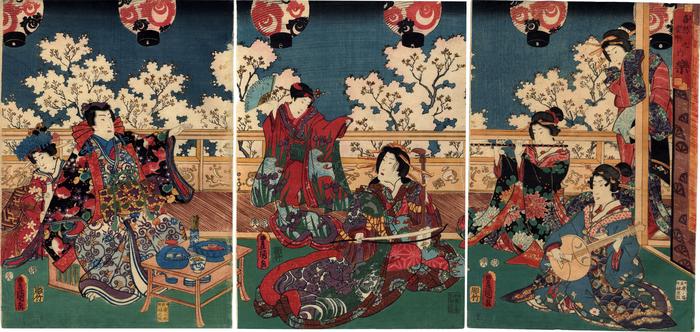Utagawa Kunisada (歌川国貞) / Toyokuni III (三代豊国) (artist 1786 – 01/12/1865)
Music (raku - 楽) from the series Joy and Anger, Love and Pleasure (Kido airaku no uchi - 喜怒愛楽之内) - a Rustic Genji theme
08/1854
30 in x 14 in (Overall dimensions) color woodblock print; ōban triptych
Signed: Toyokuni ga (豊国画)
Publisher: Hayashiya Shōgorō (Marks 106 seal 22-049)
Carver's seal: Hori Take
Censor's seal: aratame
Date seal: Tiger 8 - 8/1854
Tokyo Metropolitan Library
Museum of Fine Arts, Boston
National Diet Library Mitsuuji is entertained by and orchestra of female performers. He is elaborately attired with a robe decorated with large koi. Above him are lanterns decorated with large flaming pearl designs. The woman in the center is playing a kokyū (胡弓) with a large bow. It is the only Japanese musical instrument that uses a bow. Behind her is a young woman who appears to be dancing to the music. Her robe is decorated with irises. The woman on the right in the front is playing a biwa (琵琶), behind her a yokobue (横笛) or transverse flute. The lower part of the balcony railing is decorated with sacred jewels.
****
About the publisher's seal on this triptych
We have added a jpeg showing an enlargement of the Hayashiya Shōgorō publisher's seal. It actually shows the general location of where it could be found in Edo. The term hirokōji (廣小路) indicates a large open space used as a firebreak at one end of the Ryōgoku (両国) bridge, which was also built at the west end to help people escape from a large fire. According to one online site Ryōgoku hirokōji was one of three such major firebreaks in Edo. The other two were in Ueno and Asakusa. There is even a small stone monument with a metal plaque commemorating the location of Ryōgoku hirokōji.
Kagaya Kichibei (加賀屋吉兵衛) and Daikokuya Heikichi (大黒屋平吉) were also located in this area. Before that in 1711 one of the most important artists in Japan, Miyagawa Chōshun (1682-1752 宮川長春), moved to the Ryōgoku hirokōji. Chōshun was the preeminent ukiyo artist of the early 18th century. This area had also become popular for its misemono (見世物) street entertainments.
Roman Adrian Cybriwsky in his Historical Dictionary of Tokyo from 1997 wrote on page 121: "SAKARIBA [盛り場]. Often translated as “amusement quarters,” “entertainment districts,” or “popular spots,” these were areas in Edo... where large numbers of people of all social ranks gathered to eat, drink and be entertained. The entertainment included at various times and places storytellers, children’s theater, musicians, jugglers, women’s sumō, and other attractions. There were quite a few sakariba in Edo, the largest ones being Ryōgoku Hirokōji near the Ryōgoku Bridge... and Okuyama in Asakusa... Most other large sakariba were also located at bridges, at open spaces created as firebreaks, and at temple grounds. The word sakariba is used to today to refer to popular night-spots in Tokyo such as Kabukicho in Shinjuku, Akasaka, and Roppongi..."
Hayashiya Shōgorō (林屋庄五郎) (publisher)
beautiful woman picture (bijin-ga - 美人画) (genre)
Yokokawa Takejirō (横川彫武) (carver)
